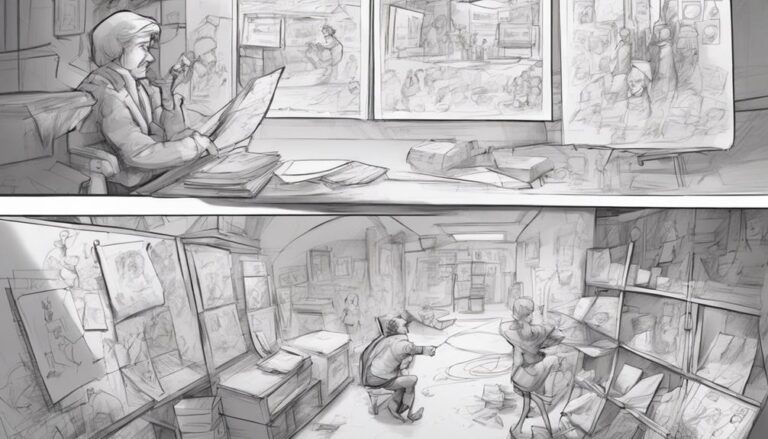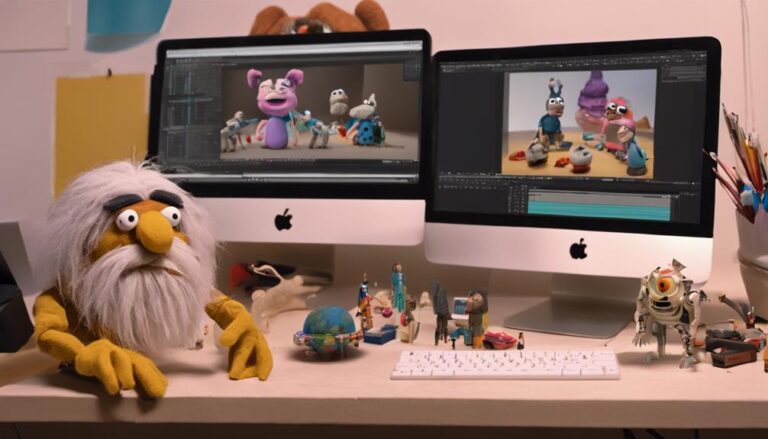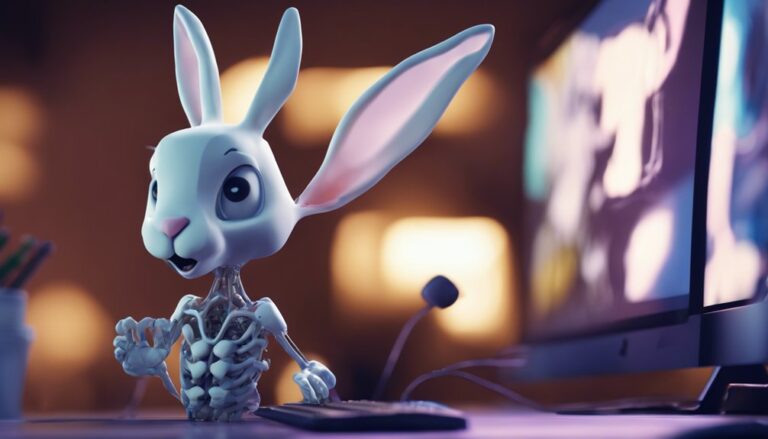Visualizing Your Pitch: Animation Development Essentials
You're about to transform your pitch into a captivating narrative by harnessing the power of animation and the principles of compelling storytelling. To start, craft a well-structured storyboard with a clear three-act structure and harmonious balance of text and visuals. A consistent visual language is key, guiding your audience through the story with a palette of colors that evoke emotions and reflect the mood. By defining your narrative tone and animation style, you'll set the stage for a strong narrative that engages and inspires. As you refine your vision, discover how to breathe life into your pitch.
Key Takeaways
- A well-crafted storyboard is essential for bringing a narrative to life with a clear three-act structure.
- Color scripting evokes emotions and creates a sense of continuity in animation development.
- A strong narrative is the backbone of a successful animation, defining the pitch tone and character arcs.
- The animation style should reflect the brand's visual identity, target audience, and story tone.
- A problem statement, solution overview, and key features are essential components of a pitch in animation development.
Creating Compelling Storyboards
Within the realm of animation development, a well-crafted storyboard is the unsung hero that brings your narrative to life.
It's the blueprint that sets the stage for the entire production, guiding every aspect of the animation process.
When creating a compelling storyboard, you'll need to focus on its structure. A clear three-act structure is essential for building tension, conveying character arcs, and resolving conflicts.
Divide your storyboard into key beats, breaking down each act into manageable chunks.
Pay attention to panel composition, as it plays a crucial role in controlling the pacing and flow of your narrative.
Each panel should serve a purpose, advancing the story or revealing character.
Balance text and visuals to create a harmonious rhythm.
Consider using different panel sizes and shapes to emphasize key moments or create tension.
Ensure that your panels are well-balanced, with a clear hierarchy of visual elements.
By focusing on storyboard structure and panel composition, you'll be able to craft a compelling visual narrative that captivates your audience.
A well-crafted storyboard will help you stay on track and ensure that your animation meets its full potential.
Designing Engaging Visual Elements
Color scripting is essential in this process.
By creating a color palette that reflects the mood and atmosphere of each scene, you can evoke emotions and create a sense of continuity. This visual language will guide the audience through the story, making it more immersive and engaging.
Visual metaphors are another powerful tool to add depth to your animation.
Crafting a Strong Narrative
A strong narrative is the backbone of any successful animation, and it's your job to craft a story that captivates and resonates with your audience.
You'll want to start by defining the pitch tone – the tone that will set the emotional foundation for your entire animation. Will it be humorous, serious, or inspirational? Whatever tone you choose, make sure it's consistent throughout your narrative.
Next, develop character arcs that showcase growth, transformation, or revelation.
Your characters should be multi-dimensional, relatable, and authentic. Give them unique personalities, motivations, and goals that drive the plot forward. As your characters navigate their journey, use conflicts, twists, and turns to create tension and drama. Make sure the stakes are high, and the outcome is uncertain.
Selecting the Right Animation Style
Consider the following key factors when selecting an animation style:
* Style evolution: Reflect on your brand's visual identity and how it has evolved over time.
Ensure your chosen style aligns with your brand's legacy and aesthetic.
- Artistic constraints: Establish clear boundaries and guidelines for your animation style to maintain consistency throughout the project.
- Target audience: Tailor your style to your target audience's preferences, demographics, and viewing habits.
- Story tone: Match your animation style to the tone of your narrative, whether it's humorous, dramatic, or educational.
- Technical feasibility: Consider the technical capabilities and limitations of your animation team when selecting a style.
Bringing Your Pitch to Life
When developing your pitch, consider the key elements that will make it compelling. Here's a breakdown of the essential components to include:
| Pitch Component | Description | Visual Scripting Tip |
|---|---|---|
| Problem Statement | Clearly define the problem you're solving | Use simple, concise language |
| Solution Overview | Introduce your solution and its benefits | Use engaging visuals to illustrate key points |
| Key Features | Highlight the unique features of your solution | Use animations to demonstrate how features work |
| Call to Action | Encourage your audience to take action | Use a clear, direct ask and a prominent call-to-action button |
Frequently Asked Questions
What Software Is Best for Beginners in Animation Development?
You're diving into animation development, and choosing the right software is key. Consider Blender, with its free trials and intuitive user interface, making it an ideal starting point for beginners to master the craft.
Can I Create Animations Without Drawing Skills?
You don't need drawing skills to create animations. Many non-artistic founders leverage visual effects, 3D modeling, and pre-made assets to overcome style limitations, focusing on storytelling and animation technique instead.
How Long Does the Average Pitch Animation Take to Develop?
When you develop a pitch animation, you'll typically spend 2-6 weeks in production, depending on complexity. You'll need to plan your production timeline and budget breakdown carefully, allocating resources to meet your vision and deadline.
What Is the Ideal Animation Length for a Pitch?
You craft a pitch that's concise, ideally 1-2 minutes long. This length respects the audience's decreasing attention span, maximizing engagement and ensuring your key message resonates, leaving a lasting impression on potential investors or clients.
Can I Repurpose My Pitch Animation for Other Uses?
You can repurpose your pitch animation for brand extension and content reuse by adapting it for social media, website explainers, or internal training videos, maximizing its value and extending its lifespan across multiple channels.
Conclusion
You've crafted a narrative, designed visuals, and chosen an animation style – now it's time to bring your pitch to life. With a clear vision and technical expertise, you can turn your ideas into a captivating animation that wins over audiences. By combining storytelling, visuals, and animation, you'll create a compelling pitch that leaves a lasting impression and sets your project up for success. This is where the magic happens, and your vision becomes reality.







